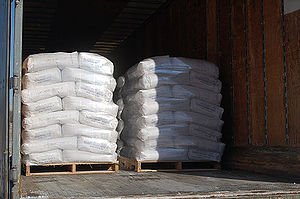Calcium hydroxide
| Calcium hydroxide | |
|---|---|

| |
| General | |
| Systematic name | Calcium(II) hydroxide |
| Other names | Slaked lime |
| Molecular formula | Ca(OH)2 |
| Molar mass | Molar mass::74.093 g/mol |
| Appearance | white powder |
| CAS number | CAS number::1305-62-0 |
| Properties | |
| Density and phase | [[Density::2.211 g/cm3]], solid |
| Solubility in water | 0.189 g/100 ml (0°C) 0.173 g/100 mL (20 °C) |
| Melting point | Melting point::580°C |
| Boiling point | none |
| Acidity (pKa) | ? |
| Basicity (pKb) | 2.37 |
| Chiral rotation [α]D | none |
| Viscosity | none cP at ?°C |
| Hazards | |
| MSDS | Material safety data sheet |
| Main hazards | Corrosive |
| NFPA 704 | |
| Flash point | Non-flammable |
| R/S statement | R: R22, R34 S: (S2), S24 |
| RTECS number | EW2800000 |
| Related compounds | |
| Other cations | |
| Related Bases | Calcium oxide |
| Except where noted otherwise, data are given for materials in their standard state (at 25 °C, 100 kPa) Disclaimer and references | |
Calcium hydroxide is known as hydrated lime, calcium hydrate or caustic lime. It is a white crystal or powder without any smell. This compound is made with reacting water and calcium quicklime. Generally, calcium hydroxide is useful in many applications such as treatment to clean water. [1]. At the same time, since it is a quite dangerous material which may cause blindness, skin burns, blisters, and irritation of a respiratory tract, an immediate treatment is essential after contacting the compound.
Properties
Calcium hydroxide is a white crystal or powder. Its molecular weight is 74.093 g/mol. Its size is about 0.2 g per 100 cm3. It melts at 580°C and does not have a boiling point which means it decomposes into oxides. When this compound obtains carbon oxide from the air, the color of the limewater becomes milky. This compound shows a strong base so it reacts hard with acid and attacks metals in water. [2] It reacts violently when mixed with compounds such as nitromethane, nitroethane, maleic anhydride, nitroparaffins, nitropropane and phosphorous. [3]
Occurrences
The formula of Calcium hydroxide is Ca(OH)2. This compound takes an form when calcium oxide combines with water. Adding an alkali to any calcium salt also produces this compound. In the laboratory, mixing calcium chloride and sodium hydroxide forms calcium hydroxide. [4] Calcium hydroxide becomes limewater when it is separated from water.
CaO + H2O → Ca(OH)2
Uses
Calcium hydroxide can be used in various kinds of fields. It is often used as an antimicrobial in dentistry. It is also a substance for making an apical barrier, a protective layer. In the case that a teeth is already infected, calcium hydroxide still can be utilized to disinfect the teeth. In hair treatment, the compound is considered the active alkaline ingredient and helps hair straighten. This happens by breaking the connection between sidulfide bonds and cysteines. In some cases, calcium hydroxide is involved in a procedure of making alcohol and soft drinks. [5] The compound is often used to neutralize an acid soils. It is also utilized for pickling and removing insects. In some aspects, this compound shares the same uses with Calcium oxide. It is necessary for steel manufacture, glass and cement. [6]
Damages
As useful as it is, calcium hydroxide can cause severe damages as well because it is very hazardous. The symptoms are hypertension, an increase of blood ratio, internal bleeding and difficulty to breathe. Skin contact will cause blistering or inflammation. Eye contact will lead to blindness or corneal damage. [7] After contacting the compound, a soapy water is necessary to wash and an immediate cure is needed. [8]
References
- ↑ [1] Unknown Author, Chemicalland21.com Accessed on March 15, 2011.
- ↑ Properties Unknown Author, eHow.com. Accessed on March 15, 2011.
- ↑ [2] eHow.com. Accessed on March 15, 2011.
- ↑ [3] Wikipedia. Accessed on March 30, 2011.
- ↑ [4] LIVESTRONG.COM. 2011. Accessed on March 30, 2011.
- ↑ [5] eHow.com. Accessed on March 15, 2011.
- ↑ [6] MSDS. 01/25/10.
- ↑ [7] LIVESTRONG.COM. 2011. Accessed on March 30,2011.
| ||||||||||||||



